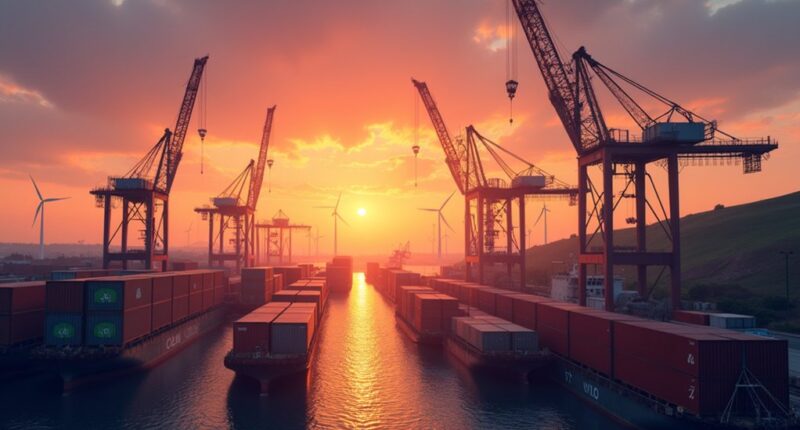The European Commission plans to allocate €70 million in 2025 to support industrial exporters affected by the Carbon Border Adjustment Mechanism (CBAM). This mechanism aims to prevent carbon leakage by ensuring that imports of carbon-heavy goods like steel and cement are subject to similar emissions costs as local products. It’s like leveling the playing field in a game. As industries adapt to these changes, there’s more to explore about the evolving regulations and impact on the market.
Quick Overview
- The European Commission allocates €70 million in 2025 to support exporters facing carbon leakage risks under the new carbon border tariff law.
- The compensation scheme targets carbon-intensive sectors like steel and cement that encounter stricter climate policies.
- Exporters must prove a greater competitive disadvantage compared to non-EU competitors to qualify for the compensation.
- The scheme is a temporary measure, with a review set for 2026 to assess its effectiveness.
- This initiative aims to prevent EU companies from relocating production due to increased climate regulations.
Overview of the Carbon Border Adjustment Mechanism (CBAM)
In the ever-evolving landscape of global trade and climate policy, the Carbon Border Adjustment Mechanism (CBAM) emerges as a game-changer, akin to a referee ensuring fair play in a high-stakes match. This EU policy levies a carbon price on imports based on their greenhouse gas emissions, aiming to prevent carbon leakage—where industries escape to countries with lax regulations. By covering carbon-intensive products like steel and cement, CBAM creates a level playing field for EU producers. It also nudges non-EU countries toward greener practices, all while supporting the EU’s ambitious climate goals. CBAM aims to reduce global warming emissions through pricing embedded emissions, making it a win-win, or at least a fair match! The mechanism incentivises emissions reduction via a cap and trade mechanism, encouraging companies to innovate and lower their carbon footprints. These carbon markets facilitate the trading of emission units, allowing businesses to purchase carbon offset projects that compensate for their unavoidable emissions.
Compensation Scheme for Affected EU Exporters
A fresh approach to supporting EU industrial exporters is being rolled out, and it’s worth paying attention to. The European Commission has earmarked €70 million for 2025, targeting sectors like steel and cement that are at risk of carbon leakage due to stricter climate policies. To qualify, exporters must prove they’re feeling the pinch more than their non-EU competitors. This scheme is a bit like a lifeboat for those steering choppy waters, ensuring fair competition. Companies navigating these regulations may face challenges from conflicting ESG standards across different regions. With a review set for 2026, it’s a temporary but vital measure to keep EU industries afloat amid changing regulations. Additionally, the CBAM risk mitigation plan is designed to support exporters facing challenges from carbon pricing pressures, as it addresses carbon leakage risk involving EU companies relocating production or non-EU products replacing EU goods.
Legislative Developments and Industry Impact
While maneuvering the complex waters of EU industrial policy, businesses are discovering the new legislative landscape shaped by the Carbon Border Adjustment Mechanism (CBAM).
As the interim phase unfolds until December 2025, companies face evolving compliance obligations, from quarterly to annual reporting of embedded emissions.
With about 10,000 businesses now liable under CBAM, the goal is to curb carbon leakage while keeping smaller players in the game.
Yet, the looming 2026 regime raises concerns over competitiveness and costs, especially as EU Regulation 2023/956 aims to ensure importers of carbon-intensive goods bear similar carbon costs as EU-produced goods under ETS.
The EU’s efforts to streamline regulations may just be the lifebuoy industries need in these choppy waters of environmental accountability, particularly with the introduction of 50-tonne mass threshold exemptions.
Companies must adapt to these changes by ensuring their emission reporting methods align with international greenhouse gas accounting standards for accurate scope classification.









